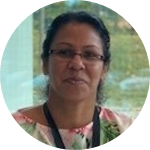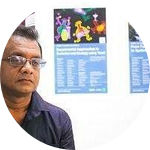About This Project
Leishmaniasisis a neglected tropical parasitic diseases in the world and is spread by the bite of sand flies. 78% of people living in the Madawachchiya area in Sri Lanka are bitten by sand flies. Many remote areas have a higher burden of leishmaniasis, despite being far away from clinical and public health services. Our research will evaluate the efficacy of a comprehensive public health intervention based out of a mobile vector clinic on reducing leishmaniasis breeding environmentand disease.
Ask the Scientists
Join The DiscussionWhat is the context of this research?
Leishmaniasis is more prevalent in poorer areas and vulnerable populations such as children, farmers and the elderly. People living in our target make a living through farmingand therefore are continually exposed to hurtful, irritating and often festering sand flies. The Madawachchiya area also experiences severe droughts, forcing inhabitants to clear the jungle in order to cultivate food, which in result disturbs the sand fly breeding areas resulting in more bites. And so the evil cycle continues because nobody is taking the time to educate or to intervene.
Further, very low levels of awareness on the disease among the local population, and the absence of dedicated vector surveillance and control volunteers are also thrive the incidence of sandfly bites.
What is the significance of this project?
A very small portion of the research community focuses on sand fly vector control / Leishmaniasis. We are passionate to be part of that small group committed to making a difference, and to help the large number of poor people affected by this. The proposed project facilitates sand fly vector control and Leishmaniasis disease control in Madawachchiya MOH area, in Sri Lanka by means of providing proper instructions and improving awareness on a continues basis which will keep staying one step ahead of the sand fly vectors responsible for Leishmaniasis parasite transmission. Thus people know how to protect themselves and their communities from sand fly vectors and Leishmaniasis disease which ultimately leads to the prevention of the epidemic situation within the Madawachchiya MOH area.
What are the goals of the project?
This campaign will fund three months of community and field activity allowing us to significantly reduce the presence of sand flies within the Madawachchiya area. Our main goals included to evaluate two specific aspects of community health intervention. First, we will teach people how to reduce sand fly habitat in the environment near their homes by following home gardening practices. Secondly, we will arrange adult sand fly insect controlling by evaluating the vector behaviours, utilizing an integrated vector control approaches, advocacy for diseases prevention and control measures. We will evaluate the success of our programs by continuous monitoring of adult sand fly population within the area.
Budget
These budget items will equip a vehicle that will give us access to Madawachchiya, a remote area. Lab materials and tools will help us to collect and control the sand flies. The field staff will also assist with community education, sand fly collectionand control. We will provide healthier food for community education events. Lastly, we will also be cultivating vegetable seedlings to distribute among the community as added incentive to attend workshops and to encourage them to keep their gardens clean which will reduce the amount of sand fly breeding spots. Our preliminary data suggests that our comprehensive intervention will reduce the adult sand fly population and reduce sand fly bites by 20%.
Endorsed by
 Project Timeline
Project Timeline
Our timeline flow-chart merely and chronologically explained the 3 stages of our program. Time to implement the studies (1 week); hire a vehicle and equip with temporary lab (1 week); sand fly adult collection, identify and destroy the sand fly breeding sites (4 weeks); educating the village community regarding sand fly control measures (3 weeks); progress monitoring/surveillance (3 week); analyse (2 week), and write up (2 week).
Jan 22, 2021
Project Launched
Mar 29, 2021
Sand fly adult collection, identify and destroy the sand fly breeding site.
Mar 29, 2021
Travel to Madawachchiya MOH area and meet the community.
Apr 08, 2021
Educating the village community regarding sand fly control measures.
Apr 29, 2021
Progress monitoring and surveillance for both sand fly vector density and community knowledge regarding control.
Meet the Team
Affiliates
Affiliates
Team Bio
Our research project team consisted of 9 additional members including;
Dr. Nayana Gunathilaka, Dr. Ajith Rathnayaka, Dr. Dinum Perera, Dr.Prasad Jayasooriya, Dr. Lahiru Udayanga, Ms. Prabuddhika Kandegedara, Mr. Tharaka Wijerathna, Mr. Ishara Jayamanna, Mr. Geethanjana Perera, and Mr. Udaya Wimalasiri
N.D.Asha Wijegunawardana
I am Asha Wijegunawardana, with 14+ years of professional experience in scientific research in vector-borne disease control, investigator-driven grant handling, and general administration work. Throughout my research carrier and postgraduate studies, I have gained knowledge for insect control using sterile insect technique (SIT), insect incompatibility technique (IIT), and mosquito transgenic experiment models for the control of Aedes and Culex mosquitoes in Sri Lanka. In addition, I was trained in handling all laboratory facilities and techniques related to Molecular Biology, Entomology, Biological Science research work which has great potential to be used for modern scientific research work. My background in Biotechnology, Molecular Biology, and entomology makes me passionate about vector-borne disease research. My hunger for knowledge and determination to turn information into action has contributed to my most recent success by launching this community-based leishmaniasis vector control project.
Chathuranga Bamunuarachchige
Dr. T.C. Bamunuarachchige is a Senior Lecturer in the Department of Bioprocess Technology, Faculty of Technology, Rajarata University of Sri Lanka. He has been a member of the Working Committee on Biotechnology and Bioethics of the National Science Foundation (NSF) in Sri Lanka and the Program Coordinator for the Technology Degree programs conducted by the RUSL. Dr. Bamunuarachchige is a certified tutor mentor trainer in distance and continuing education. He has served as the Program Coordinator of the Distance education program from 2009-2012 at RUSL. Dr. Bamunuarachchige has authored about 35 scientific publications and supervised several postgraduate students in the field of Biotechnology and Molecular Biology. He has a wealth of experience in writing proposals for competitive grants including World Bank and Asian Development Bank-funded projects. Dr. Bamunuarachchige is a certified peer reviewer under the Elsevier Researcher Academy and has served as a reviewer for six international and several local journals. He is a prominent reviewer of Biotechnology related proposals submitted to the two leading funding agencies in Sri Lanka the NSF and the NRC.
Additional Information
We will allocate approximately 1/3 of the funds to each of the 3 stages of our research. Stage 1 will help to equip a vehicle to act as a mobile vector clinic. Stage 2 will help to conduct community education work for sand fly vector control measures. Stage 3 will examine the progress of the community awareness regarding the sand fly and their control, the success of the sand fly control program through MVSU.
Activities of the field scientific staff will include research design, materials preparation, data analysis, paper write-up, and results dissemination. When each stage is complete, full lab notes will be provided via our Experiment page.
Additional Information on Crowdfunding for Science
With more and more constraints on scientific funding worldwide, researchers are having a difficult time securing supports for their work, especially among those relatively early in their career like PhD students, postdoctoral fellows or young principal investigators. Funding is crucial at this stage where new investigators can establish their career path.
With many startups turning to crowdfunding to help complete their projects, you are now seeing new campaigns offering all these fun gadgets and technologies almost every day. What crowdfunding does here is to bring you, as potential customers, closer to the companies. It generates buzz for the biz, and you get a glimpse of the products you will likely purchase. Crowdfunding connects the startup owners with broader audiences who are as passionate about the projects as they are. In turn, these audiences have a chance to be a part of the projects through small donations. While the money raised from crowdfunding may not entirely replace the more traditional routes like angel funding or venture capital, it allows the people who make the campaigns to take their first few steps.
Just like crowdfunding for business, crowdfunding for researches allows scientists to connect with the people they are helping. With the traditional route of research grants, you share your ideas with limited circles of people--grant reviewers, experts in the fields, and that friend you asked to proofread your proposal in exchange for freshly-baked cookies. Now, with crowdfunding campaigns, you, as scientists, are sharing your ideas, hope, and goal with the public. These are the people who are likely going to benefit from your next discoveries firsthand, whether it be a cure for cancer or a new anti-malaria drug, or a new strain of rice with a higher yield.
To give back to your backers, you, the science guys, are updating them on your progress, letting them know that even just a small amount of donations can drive your experiments towards the next big discovery. In a way, this is your product to give back to your backers. With the magic of the internet, crowdfunding campaigns can bridge the gap between the lab bench and the public, thus increasing transparency and building trust between scientists and the general public.
It is true that fundraised through crowdfunding is often far from the traditional research grants, and its success is not guaranteed. However, a small amount of money can allow researchers to conduct some preliminary experiments, set up a new space for future projects, or generate enough data to make that Figure 1 for their grant proposal. Everything counts.
Crowdfunding is relatively new and unexplored territory for scientific research communities. TDR, the Special Programme for Research and Training in Tropical Diseases, at World Health Organization recognizes this as a great opportunity to help researchers fund their projects given the increasing difficulties to secure research funding.
Project Backers
- 93Backers
- 128%Funded
- $7,244Total Donations
- $77.89Average Donation





.png)